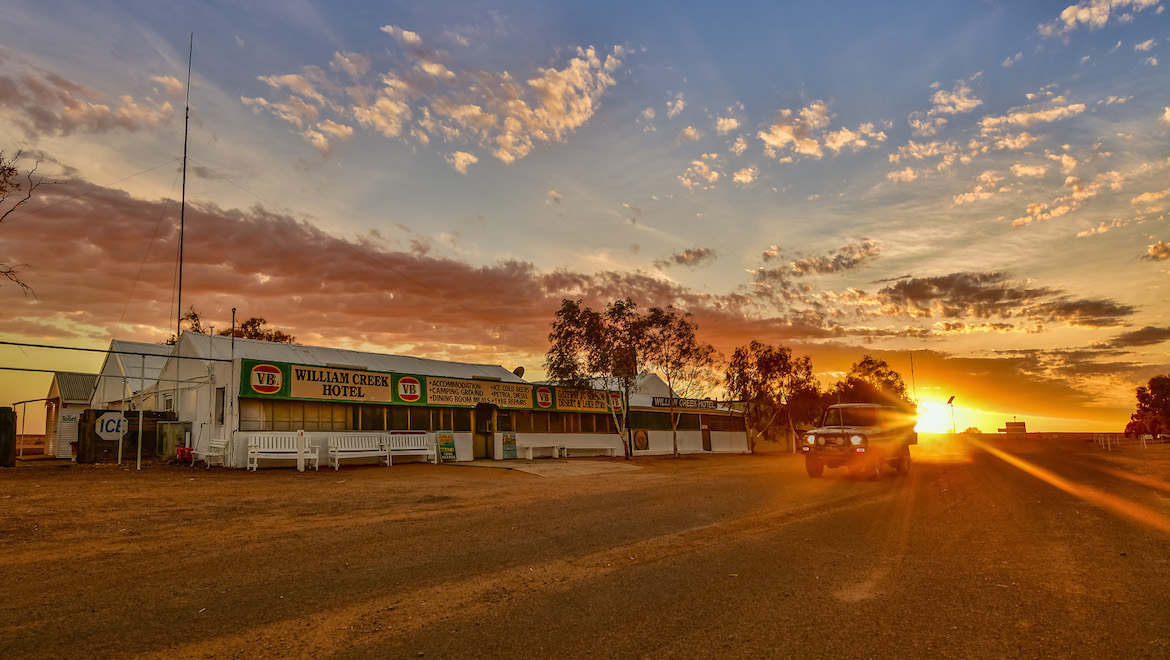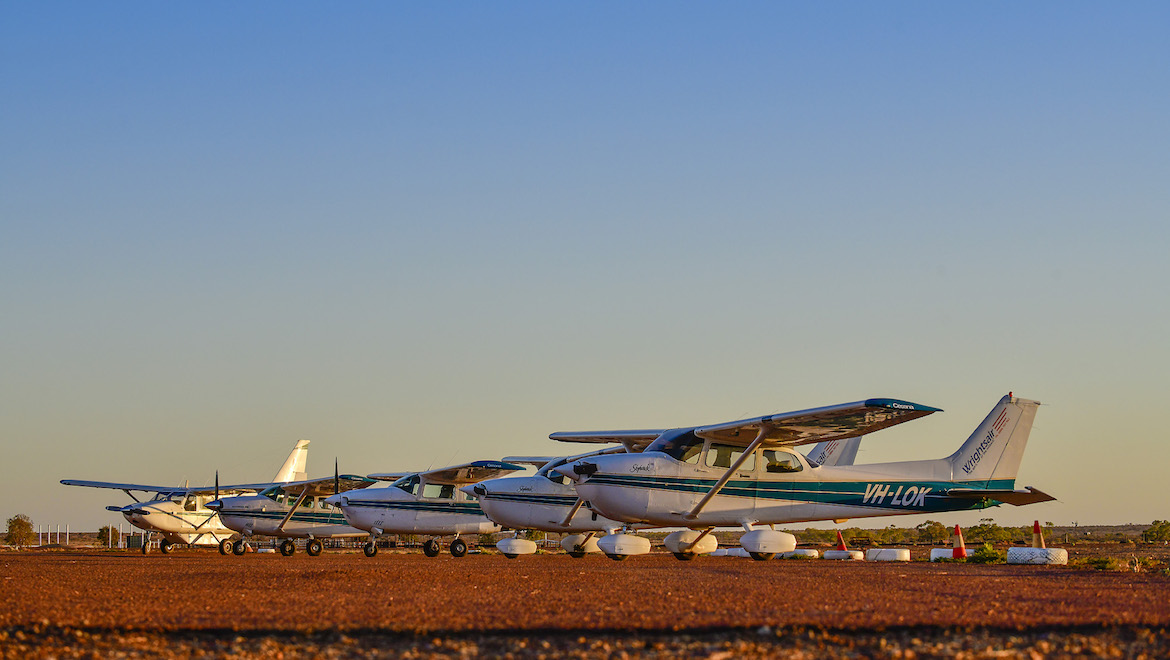This story about scenic flight operator Wrightsair first appeared in the October 2019 edition of Australian Aviation magazine.

Amid all the trauma and heartache of one of the worst droughts on record, rain in some parts of Australia has led to a dramatic transformation of the landscape, and a boost to one of our oldest regional aviation businesses.
It has been a boom year for outback scenic flight operator Trevor Wright and his Wrightsair aviation group, thanks to two unusually heavy cyclonic deluges in north-western Queensland.
The combination sent floodwaters surging through the Channel Country into Lake Eyre, and sent tourism numbers surging along with it.
Wright admitted his operation was “under the pump” at times in July, with high demand for fuel from Outback travellers creating long queues at his two bowsers, next to his pub, at William Creek in South Australia’s Far North.
And that translated to heavy demand for sightseeing flights at the remote William Creek settlement Wrightsair calls home.
“I’ve never seen tourism at this level in the Far North before,” Wright told Australian Aviation.
The lure was the biggest inflow to Lake Eyre since 1974, starting in January from the remnants of Cyclone Penny with initial flow down the inland rivers which run towards Australia’s lowest point in Lake Eyre North.
Then the flood was reinforced by Cyclone Trevor in late March which dumped up to 200mm of rain in 24 hours on north-western Queensland, sending a new flow down the Diamantina and Georgina Rivers and isolating Birdsville from the south on its way to Lake Eyre.
The water covered up to 80 per cent of the 1.2 million square kilometre basin at its peak, sparking demand for flights over Lake Eyre North, the main – but not the only – focus for Wrightsair operations.
William Creek is a tiny outpost on the challenging Oodnadatta Track, about 650km north of Adelaide, and about 60km from the western shore of Kati Thanda-Lake Eyre, the Aboriginal prefix adopted after the Arabana people were granted native title and a national park declared in 2012.
[vc_gmaps link=”#E-8_JTNDaWZyYW1lJTIwc3JjJTNEJTIyaHR0cHMlM0ElMkYlMkZ3d3cuZ29vZ2xlLmNvbSUyRm1hcHMlMkZlbWJlZCUzRnBiJTNEJTIxMW0xOCUyMTFtMTIlMjExbTMlMjExZDE3ODA3NzMuMzg3ODkxNzM1NCUyMTJkMTM2LjMxOTY5NTA5OTM5NzU2JTIxM2QtMjkuMzY5MDgwMDg5NjY5JTIxMm0zJTIxMWYwJTIxMmYwJTIxM2YwJTIxM20yJTIxMWkxMDI0JTIxMmk3NjglMjE0ZjEzLjElMjEzbTMlMjExbTIlMjExczB4NmE5YzkyYWQ3OGMwYjE3NSUyNTNBMHg0MDMzNjU0NjI4ZjIwNjAlMjEyc1dpbGxpYW0lMjUyMENyZWVrJTI1MjBTQSUyNTIwNTcyMyUyMTVlMCUyMTNtMiUyMTFzZW4lMjEyc2F1JTIxNHYxNTczMjQ4NjEyNTMzJTIxNW0yJTIxMXNlbiUyMTJzYXUlMjIlMjB3aWR0aCUzRCUyMjYwMCUyMiUyMGhlaWdodCUzRCUyMjQ1MCUyMiUyMGZyYW1lYm9yZGVyJTNEJTIyMCUyMiUyMHN0eWxlJTNEJTIyYm9yZGVyJTNBMCUzQiUyMiUyMGFsbG93ZnVsbHNjcmVlbiUzRCUyMiUyMiUzRSUzQyUyRmlmcmFtZSUzRQ==” title=”William Creek, South Australia (via Google Maps)”]
A fleet of 24 Wrightsair sightseeing and charter aircraft call William Creek home. The place is a relic of the steam train era, when the old Ghan train service between Adelaide and Alice Springs called here for coal while its passengers headed for the pub only metres away from the track.
Pilot Trevor Wright, 63, who learned to fly at 17 in his northern Victoria home town of Boort, and started his private flying with a tiny 1200cc Volksplane before graduating to a Piper Colt for weekend flying, decided to land at William Creek on a flight to Alice Springs in about 1990.
He thought its outback location and proximity to the great salt lake offered potential for a tourism and charter business.
“I’d heard about this little place, decided to take a look and found it totally unique,” Wright said.
“There’s this huge salt lake, one of the biggest in the world, which was starting to attract more attention.”

He started Wrightsair with a Cessna 172 and a recruited pilot in 1992, operating from a bush airstrip behind the William Creek pub.
The venture started slowly – “1992 was a dry year, there wasn’t much demand for scenic flights,” Wright recalls wryly. But some people wanted to look at the vast salt lake system, and the embryonic outfit picked up some local charter work.
As the word got around, more travellers began calling in at William Creek and within three years he acquired a second aircraft, and tourism grew steadily, fuelled by the periodic but unpredictable outback floods which bring some water to the lake every three to five years, with a major inflow every decade or so.
And it was also helped by a trend to ecotourism. Wright says the remote Lake Eyre region has been “coming into vogue” among people seeking a different outback experience.
And this year has brought visitors on a two-pronged outback odyssey, to see the Lake Eyre floods and to continue on to visit Uluru before it is closed to climbers for good on October 26.
From his small start, Wright gradually increased his aircraft fleet to cater for the growing demand and more recently opted for a couple of larger aircraft.
They include two 13-passenger Cessna Grand Caravans, one bought in 2017 from Broome and the other acquired this year from the Gold Coast’s Seair Touring, and two seven-passenger, Australian-made GA-8 Airvans.
The rest of the fleet includes Cessna 172s, 182s, 206s, 207s and 210s. Wright says the Cessnas are well-suited to bush operations.
As well, there’s a low-wing, twin-engine Aerostar, not suitable for sightseeing but used for outback charter work.
Wright supplements his fleet with short-term leases on occasion but prefers to have his own machines, “so we have full control”.
Over this busy past winter season, with Lake Eyre at its highest level since 1974, Wrightsair was operating up to 25 flights a day, and averaging 20.
We book ourselves on one of them.

Promptly at 10am on a clear June morning, after a check of the passenger list and a safety briefing, our Grand Caravan flight with two pilots and 11 passengers, takes off on a two-hour aerial sightseeing adventure.
It takes us at 500 feet over Belt Bay, which contains the lowest point in Australia – 15.2 metres below sea level and containing water to a depth of about two metres at this time.
We cross the Goyder Channel, which funnels water into Lake Eyre South, but it is dry now. However, there is water in Madigan Gulf, where – in a dry year – Donald Campbell in his Bluebird racing car broke the world land speed record with a run of 648.7km/h. Our Grand Caravan cruises above the site at only 150 knots (278km/h).
Now the shallow flood waters spread widely across the lake surface. Below is an island which usually in flood times contains a huge pelican rookery, but the second inflow from Cyclone Trevor has attracted the birds further north to plunder the schools of freshwater fish which miraculously appear when the floods descend.
The flight follows the winding Warburton River, which brings the water to Lake Eyre from the overflowing Goyder Lagoon, which in turn is fed by the Diamantina and Georgina Rivers and their tributaries up to 1,000kms away.
After the salt-encrusted shores of Lake Eyre, the Warburton is lined with green, as new vegetation flourishes on its banks.

We sight Goyder Lagoon as the aircraft banks away to the west, bringing the sandhills of the Simpson Desert into view, then we’re over Anna Creek station, Australia’s largest cattle run covering almost 23,700 square kilometres, and on approach to William Creek and its 1,200-metre runway, which was sealed in 2012.
Back on the ground, in the pub he now owns – along with the large caravan park, cabin accommodation for visitors and staff, and two or three houses – Trevor Wright talks about his “passion” for outback tourism.
He won’t say how much he has invested, and continues to invest, in his venture, but admits it has taken up all his time and energy since launching Wrightsair in 1992.
Along the way, as people moved out of the isolated settlement, he has gained ownership of houses, the caravan park, the pub and the airport.
That it is paying off is obvious by the numbers of people in the caravan park and accommodation in 56 pub and cabin rooms when we visit. His William Creek operation has attracted “a huge number” of private flights this year, with his airport offering a swipe-card system for Avgas and Jet fuel.
While William Creek is the heartland, Wright has steadily diversified his operations, particularly to cover the quiet times when Lake Eyre reverts to being a dry salt pan, and bookings fall away.
The operations extend to the opal mining centre of Coober Pedy, the spectacular eroded sandstone Painted Hills, the remote mound springs of Dalhousie, north of Oodnadatta, to Birdsville and to Innamincka on Cooper Creek.

Apart from his William Creek headquarters, Wright has two aircraft based at Coober Pedy, and two at Marree. Another two are contracted to aerial sightseeing from Wilpena Pound in the Flinders Ranges, and he has stationed two at Cairns in North Queensland, one of which was brought back to William Creek this winter to assist with demand for Lake Eyre flights.
Crewing his aircraft – under the guidance of chief pilot Matt Harnetty (who joined Wrightsair in 2016) are some 25, mostly young commercial pilots.
Despite the remote location, Wright says he has no problem attracting pilots because he can offer the opportunity of building up flying hours towards their wider ambitions in aviation. One of his recruits is now flying with Regional Express (Rex), he says proudly.
Soon, as summer approaches and the lake dries up again, most will disperse to other jobs around the country. Wrightsair will keep three or four aircraft in the Lake Eyre region for contract work and a few scenic flights.
“It’s really the water that drives it,” says Wright of the tourism side of his business.
The William Creek airport was upgraded in 2010 through the Commonwealth remote aerodrome safety program, which incorporated solar lighting and other aids to enable 24-hour operations, and two years later the strip was sealed.
Trevor Wright’s “vision for the future” includes a further upgrade of the airport, including a lengthening of the runway from 1,200m to 1,400m, to enable larger aircraft such as Fokker F50s to land and takeoff.
“People want to get out here more comfortably,” he says. “Larger aircraft fit that bill.”
https://www.facebook.com/Wrightsair/videos/439052183612359/
VIDEO: A look at Belt Bay in Lake Eyre from the Wrightsair Facebook page.
This story first appeared in the October 2019 edition of Australian Aviation magazine.













